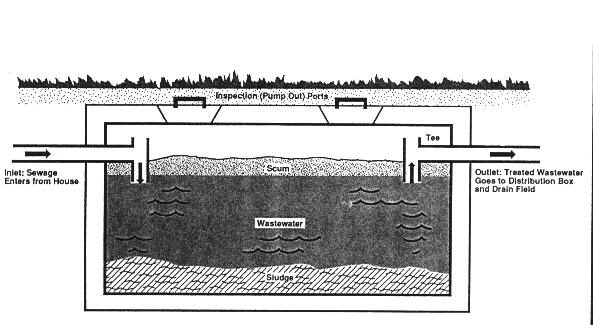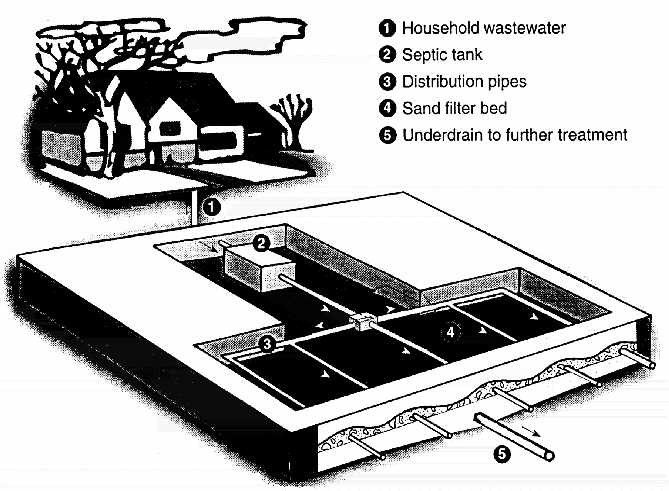Septic/Sand Filter Systems

Our septic department consists of two fully equipped tanker trucks and a knowledgeable staff to address any problems you may have. The septic trucks are capable of pumping liquid from 500 feet away with a 3,000 gallon capacity. They include high velocity water jet units to deal with any line blockage that may be found during a routine septic tank visit, including revitalizing leach lines. We also have the capability of rejuvenating leach fields and other low lying areas with drainage problems(Terralift) without disturbing the ground surface. In addition to servicing and repairing septic systems, we also design and install systems to meet any residential or commercial need.
What is a septic system?
A septic system, consists of two main components; the septic tank, which takes in and pretreats the sewage, and the drainage area, a.k.a., a leach or lateral field. The system also includes a sewer line which connects all plumbing fixtures from the dwelling to the septic tank and a distribution box which connects the septic tank to the drainage field. The septic tank is usually located 10-15 feet from the dwelling.
The purpose of a septic system is to treat and dispose of wastewater generated by the occupants. When properly installed and maintained, septic systems are more economical than sanitary sewers and just as efficient.
How the system works.

All wastewater from the dwelling enters the septic tank where primary treatment occurs. Anaerobic bacteria (bacteria found in environments without oxygen) thrive in the septic tank where they organically break down the solids, creating sludge. Lighter materials such as grease and soap float to the top of the tank and from a layer called scum. This settling process allows virtually all of the wastewater to flow out of the septic tank free of grease, soap and solids. It is important to remember that septic tank inlet and outlet pipes are near the top of the tank. Thus, the septic tank always appears full.
The relatively clear wastewater exits the septic tank outlet and flows into the distribution box (D-box) which evenly distributes the wastewater flow throughout the drainage field. Once in the drainage field, the wastewater passes through perforated lateral pipes, a layer of crushed stone and finally through several feet of unsaturated soil. As the treated wastewater travels through the soil, bacteria die off and the water is purified.
While property and lot sizes differ, most septic systems include a septic tank, a distribution box and a lateral or drainage field. Some systems have a seepage pit or cesspool instead of a lateral field. Septic tanks, distribution boxes and seepage pits are commonly made of precast concrete. The perforated pipes in the drainage field are often made of P.V.C. pipe which lay buried in several feet of crushed stone.
Town regulations, health codes and soil conditions often govern the system design in your area. You may want to contact municipal offices to obtain specific codes or a copy of the property survey.
What is a sand filter system?
Sand filter systems are similar in design as septic systems but differ in the area of filtration from standard septic systems. A sand filter system is used for existing residences with limited land availability. The process is also applicable to soils which will not allow the installation of a standard septic system. Sand filtration is achieved through the intermittent application of wastewater to a bed of granular material which is underdrained to collect and discharge the final treated wastewater. The process is highly efficient, yet requires a minimum of operation and maintenance.

How the system works
As with a septic system, all wastewater generated from the dwelling enters the septic tank where primary treatment occurs. The relatively clear wastewater exits the tank outlet and flows into the distribution box (D-box). Again, this evenly distributes the wastewater flow throughout the drainage field. The difference between a sand filter system and a septic system lies in the drainage field. The perforated pipes in a sand filter drainage field are imbedded in granular materials 24 to 36 inches deep and underlain by graded gravel and collecting tiles. The granular materials provide physical straining and sedimentation of solid materials within the media grains. The wastewater flows from the perforated pipe through the granular material, where it is purified, and is accumulated in the collecting tile. Once in the collecting tile, the purified water is either gravity fed or pumped through a chlorinator and into a pump tank. The pump tank monitors and discharges the purified water into land or surface systems.
SYSTEM MAINTENANCE
Periodic maintenance is the key to extending the life of your septic system and preventing costly repairs. When the combined depth of the sludge and scum layers equal one-third of the septic tank capacity, the tank should be pumped. This accumulation should be pumped a minimum of every three years, or more frequently if your household consists of four people or more.
The drain field is the most important component of the septic system and generally requires no maintenance unless your system has been neglected. When properly installed and sized, it will accommodate treated wastewater (effluent) from your septic tank for many years.
Pumping your septic tank is probably the single most important thing you can do to protect your system. If the buildup of solids in the tank becomes too high and solids move to the drain field, this could clog and strain the system to the point where a new drain field will be needed.
In most cases, revitalizing the leach lines will restore life back into your system. This process consists of cleaning the line from the house to the tank, the septic tank, high pressure clean the leach lines and implement enzyme starter in the tank.
TERRALIFTTM
For those systems where a revitalization is ineffective, the TERRALIFTTM is an alternative solution. This procedure is fast, effective and relatively inexpensive in comparison to installing a new leach field. It solve a number of soil problems - including compaction, saturation and improper drainage without disturbing the ground surface.
Tips:
| Know where your septic tank is located | |
| Install a riser on the main cover for easy access | |
| Pump your tank regularly | |
| Fix all leaky faucets and toilets | |
| Never put harmful materials into your septic tank |
Drain Doctor Professional Services Include:
| Sewer & Drain Cleaning | |
| Complete Plumbing Needs | |
| Hot Water Heater | |
| Sump Pumps | |
| Sewer & Waterline Repair & Installation | |
| High Pressure Jetting | |
| Explosion Proof Video Pipe Inspection | |
| Back Flow Prevention Service | |
| Industrial Vacuuming & Cleaning | |
| Septic System Installation | |
| Septic & Holding Tank Cleaning | |
| Leach Line & Ground Revitalization | |
| Grease Trap Cleaning | |
| Responsible Wastewater Management |
The Drain Doctor has been providing responsible wastewater management since 1963. We use only approved publicly owned wastewater treatment facilities (POWTs) for the disposal of septage. Be assured that the wastewater collected from your home is going to be safely and responsibly handled by trained and licensed professionals.
Fully licensed and insured, J.A. Brundage The Drain Doctor is Western New York’s premier wastewater management company. Knowledgeable sales representatives work with you to develop a complete maintenance program, including compliance assistance. All of our technicians are certified journeyman plumbers, and drivers have current CDLs (commercial driver’s license). The Drain Doctor provides prompt reliable service to several hundred residential and commercial customers throughout New York.